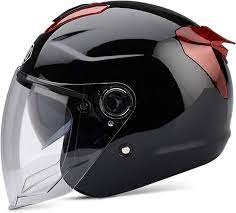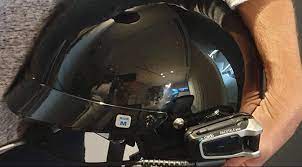Enhance Your Ride: Experience the Convenience of a Motorcycle Helmet with Sun Visor

The Benefits of a Motorcycle Helmet with Sun Visor
Motorcycle helmets are essential for rider safety, providing protection in the event of an accident. But what about those sunny days when the glare of the sun can be a major distraction on the road? This is where a motorcycle helmet with a built-in sun visor comes in handy.
One of the key benefits of a helmet with a sun visor is convenience. Instead of having to carry around an extra pair of sunglasses or goggles, riders can simply flip down the built-in visor to shield their eyes from the sun’s rays. This not only saves space but also ensures that riders are always prepared for changing light conditions.
In addition to convenience, a sun visor on a motorcycle helmet offers practical advantages as well. The visor helps reduce glare, making it easier for riders to see clearly and maintain focus on the road ahead. This can be especially important when riding at high speeds or in challenging weather conditions.
Furthermore, a helmet with a sun visor provides added protection for the rider’s eyes. In addition to shielding against sunlight, the visor can also help protect against dust, debris, and insects that may be kicked up while riding. This extra layer of protection can make for a more comfortable and safer riding experience.
Overall, investing in a motorcycle helmet with a sun visor is not only practical but also enhances rider safety and comfort on the road. With its convenience, glare reduction benefits, and added eye protection, this type of helmet is a valuable accessory for any motorcyclist looking to enjoy their ride while staying safe and focused.
9 Advantages of Motorcycle Helmets with Integrated Sun Visors: Combining Safety, Comfort, and Convenience
- Convenient sun protection without the need for additional sunglasses or goggles.
- Saves space by eliminating the need to carry extra eyewear.
- Reduces glare from the sun, improving visibility on the road.
- Enhances rider safety by ensuring clear vision in varying light conditions.
- Provides added eye protection against dust, debris, and insects while riding.
- Easy to use with a simple flip-down mechanism for quick adjustment.
- Offers practicality and functionality in one integrated design.
- Helps maintain focus and concentration by reducing eye strain from sunlight.
- Adds an extra layer of comfort for long rides under sunny conditions.
Three Drawbacks of Motorcycle Helmets with Built-In Sun Visors: Customisation Limits, Ventilation Concerns, and Added Weight
- Limited customization options as the sun visor is usually built-in and not interchangeable with different tint levels or styles.
- Potential for reduced airflow and ventilation compared to helmets without a sun visor, which may lead to discomfort in hot weather.
- Additional weight due to the integrated sun visor, which could cause neck strain during long rides or impact overall comfort.
Convenient sun protection without the need for additional sunglasses or goggles.
A significant advantage of a motorcycle helmet equipped with a sun visor is the convenience it offers in providing sun protection without the necessity of carrying extra sunglasses or goggles. Riders can simply activate the built-in visor to shield their eyes from the sun’s glare, ensuring they always have a solution at hand for changing light conditions. This practical feature not only saves space but also ensures that riders can maintain clear vision and focus on the road without the hassle of managing additional eyewear.
Saves space by eliminating the need to carry extra eyewear.
A significant advantage of a motorcycle helmet with a sun visor is its ability to save space by eliminating the need to carry extra eyewear. Riders no longer have to worry about carrying additional sunglasses or goggles, as the built-in visor conveniently provides protection from the sun’s glare. This not only streamlines the rider’s gear but also ensures that they are always prepared for varying light conditions while on the road. The convenience of having a sun visor integrated into the helmet enhances the overall riding experience by reducing clutter and simplifying preparation for any ride.
Reduces glare from the sun, improving visibility on the road.
One significant advantage of a motorcycle helmet equipped with a sun visor is its ability to reduce glare from the sun, thereby enhancing visibility on the road. By blocking out the intense sunlight that can cause distractions and hinder clear vision, the sun visor allows riders to maintain focus and better navigate their surroundings. This improved visibility not only increases safety for the rider but also contributes to a more comfortable and enjoyable riding experience, especially when travelling in bright and sunny conditions.
Enhances rider safety by ensuring clear vision in varying light conditions.
A motorcycle helmet with a sun visor enhances rider safety by ensuring clear vision in varying light conditions. The built-in visor helps reduce glare from the sun, making it easier for riders to see the road ahead without being hindered by bright sunlight. This clear visibility is crucial for maintaining focus and reacting quickly to changing road conditions, ultimately contributing to a safer riding experience for motorcyclists.
Provides added eye protection against dust, debris, and insects while riding.
A significant advantage of using a motorcycle helmet with a sun visor is the added eye protection it offers against dust, debris, and insects while riding. The built-in visor acts as a barrier, shielding the rider’s eyes from potentially harmful particles that may be kicked up from the road or surrounding environment. This extra layer of protection not only enhances rider comfort by preventing irritation but also contributes to overall safety on the road by ensuring clear vision and minimizing distractions caused by external elements.
Easy to use with a simple flip-down mechanism for quick adjustment.
One of the standout advantages of a motorcycle helmet equipped with a sun visor is its user-friendly design featuring a straightforward flip-down mechanism for swift and effortless adjustment. This convenient feature allows riders to easily deploy the sun visor with a simple motion, providing quick relief from glaring sunlight without the need for additional accessories or complex adjustments. The intuitive nature of the flip-down mechanism ensures that riders can efficiently adapt to changing light conditions on the road, enhancing both convenience and safety during their journey.
Offers practicality and functionality in one integrated design.
A motorcycle helmet with a sun visor offers practicality and functionality in one integrated design, making it a convenient choice for riders. By combining the benefits of sun protection and glare reduction into the helmet itself, riders can enjoy a streamlined and efficient solution that enhances their riding experience. This integrated design not only saves space and eliminates the need for carrying extra accessories but also ensures that riders are always prepared for varying light conditions on the road. Overall, the practicality and functionality of a motorcycle helmet with a sun visor make it a valuable asset for any rider seeking both convenience and enhanced safety while out on their motorcycle.
Helps maintain focus and concentration by reducing eye strain from sunlight.
A motorcycle helmet with a sun visor offers the valuable benefit of helping riders maintain focus and concentration on the road by reducing eye strain caused by sunlight. By shielding the eyes from harsh glare, the sun visor allows riders to see clearly and comfortably, ensuring that they can stay attentive and alert while navigating various riding conditions. This feature not only enhances safety but also contributes to a more enjoyable and stress-free riding experience, allowing riders to focus on the journey ahead with greater ease.
Adds an extra layer of comfort for long rides under sunny conditions.
A motorcycle helmet with a sun visor offers the advantage of adding an extra layer of comfort for riders during long journeys under sunny conditions. The built-in visor helps to shield the eyes from the harsh glare of the sun, reducing eye strain and fatigue. This added comfort allows riders to stay focused and enjoy their ride without constantly squinting or struggling to see clearly, making long rides in sunny weather more enjoyable and relaxing.
Limited customization options as the sun visor is usually built-in and not interchangeable with different tint levels or styles.
One drawback of motorcycle helmets with built-in sun visors is the limited customization options they offer. Unlike detachable visors or external accessories, the integrated sun visor in these helmets typically comes in a fixed tint level and style. This lack of interchangeability can be restrictive for riders who prefer to adjust their visor based on varying light conditions or personal preferences. Riders looking for more flexibility in customizing their helmet’s sun protection may find themselves limited by the built-in design of these helmets.
Potential for reduced airflow and ventilation compared to helmets without a sun visor, which may lead to discomfort in hot weather.
One drawback of a motorcycle helmet with a sun visor is the potential for reduced airflow and ventilation compared to helmets without a sun visor. The presence of a built-in visor can restrict the amount of air circulating inside the helmet, especially in hot weather conditions. This reduced airflow may lead to discomfort for riders, causing them to feel overheated and sweaty during longer rides. Riders who prioritize breathability and ventilation may find that helmets without a sun visor offer a cooler and more comfortable experience, particularly in warmer climates or during summer riding seasons.
Additional weight due to the integrated sun visor, which could cause neck strain during long rides or impact overall comfort.
One notable drawback of a motorcycle helmet with an integrated sun visor is the added weight it brings. While the sun visor provides convenience and practical benefits, the extra weight can potentially lead to neck strain, especially during long rides. The increased load on the neck muscles from carrying the additional weight may impact rider comfort and contribute to fatigue over extended periods of riding. Riders should consider this factor when choosing a helmet with a built-in sun visor, balancing the benefits of sun protection with the potential discomfort caused by the added weight.

